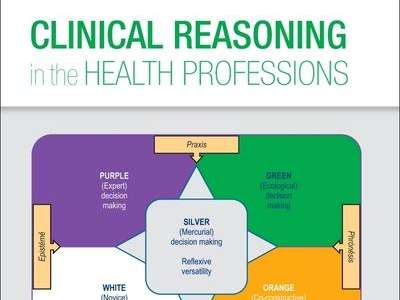
By Higgs, Jensen, Loftus & Christensen
How often do we actively reflect on our clinical reasoning skills and seek improvement, or have we reached a stage in our careers where it is a skill taken for granted and instinctively carried out? Are we aware of the similarities and differences between our clinical reasoning process and that of our fellow medical professionals and other Allied Health Professionals (AHPs)? Until reading this book, I confess I had not given clinical reasoning much deliberate thought in my continuing professional development (CPD). We are usually aware of the need to keep up to date with developments in treatment processes, new equipment, changes in the demographics of our society and evidence-based practice. And yet this book argues that clinical reasoning is a skill that also needs to adapt and change in light of these developments.
The authors point out that society is changing, bringing differences that challenge our practice in the western world. For example, our ageing population brings an increase in people having co-morbidities and chronic diagnoses, AHPs are more autonomous, there is an increase in multidisciplinary working (reablement and integrated teams spring to mind) and populations are becoming more diverse. Advances in science and technology bring further challenges, such as the development of artificial intelligence to aid diagnosis, although the authors note that the human judgement required in clinical reasoning makes it difficult to replicate by computer models – we are perhaps safe from computers taking our jobs!
The fourth edition of this book has been published to update the text and reflect these new issues and developments, and it gives a strong argument for the need for clinical reasoning to evolve. I have not read an earlier version, so I cannot comment on how much has changed.
The editors give a five-page list of contributors who, between them, represent a wide range of health professions from predominantly western world countries (UK, Canada, Australia, and America featuring heavily). This makes for a very representative text which collates best practice and theory from around the world. It is written in such a way that I never felt excluded from certain chapters because I am an occupational therapist. When the authors referred to models or research from other professions, I actually found it very interesting to see how clinical reasoning is applied in other professions.
There are six sections to this substantial text book, each with at least six detailed chapters, for example Understanding Clinical Reasoning; The Changing Context of Clinical Reasoning and Practice; Collaborative and Transdisciplinary Reasoning. Section four, Clinical Reasoning and the Professions, gives a chapter each for ten different professions, including medicine, physiotherapy and occupational therapy. Clinical scientists and rehabilitation engineers are not directly addressed in this book. The next two sections examine the teaching and learning of clinical reasoning, including learning to research the subject.
At the beginning of each chapter there is a list of keywords and abbreviations and throughout the text, boxes are used to describe terms used in more detail. Case examples are widely given which help to bring context to the theory, supported by occasional diagrams.
I found it interesting to consider clinical reasoning as a capability, not just a process, and therefore a skill that can be developed and taught. There are explanations of a range of skill levels from practitioner to expert, and how these might look in a professional. Breaking down clinical reasoning into its component parts helps to identify how to improve or support students and newer professionals who may be struggling with this skill. There is an examination of the language of clinical reasoning, and how it is studied and researched. Consideration is also given to ethical reasoning, with particular reference to private models of health care and care home funding potentially creating conflict between what ought to happen and what actually happens in practice. Again, an in depth case study is used as the chapter progresses to give real world context to the theory being explained.
The authors give a strong argument that clinical reasoning is becoming more significant and needs to adjust; for example, they present a case for changing the term to professional reasoning, as more professions move away from clinical settings to community – particularly mentioning occupational therapy.
So, who is this book useful for? In my opinion, this book would be a valuable tool for those supervising students or newly qualified staff to support the development of their clinical reasoning. The reflection points throughout the book would support self-directed learners to use this book for CPD, preventing them from getting stale and continuing on auto pilot. Changing our own clinical reasoning process could enable the service users we work with to be more involved, and therefore increase their motivation and participation/compliance. This was a view that resonated with me as an occupational therapist, and encompasses what I am sure we are all aiming to achieve.
For those in teaching roles, there are signposts to useful theories and texts to extend the subject. The book describes ways to identify those learners who are more naturally suited to clinical reasoning and those who may struggle and need more support. By breaking clinical reasoning down into component parts, it helps to identify specific areas for improvement and how to support people to achieve this.
I found it refreshing to go “back to basics” (yet they are very detailed basics) to understand my clinical reasoning process and the factors that influence it, and how I can strive towards “expert” status. I am sure it is a book I will go back to as I challenge myself to ensure I do not become complacent in practice.






.jpg)



no comments
Add your comment...